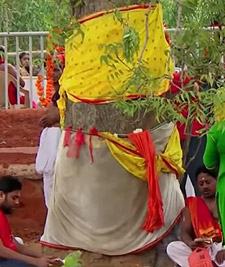

Loading Section...
The bodies of the Deities are made of Neem (Margo) wood. The first step taken in this connection is the search of Sacred Daru (wood logs) to create the new Deities. This is known as as Banayaga Parba or Banayaga Yatra of the Nabakalebara ritual. The procedure relating to searching of Darus begins from Chaitra Sukla Dasami tithi i.e the 10th day of the bright fortnight of the month of Chaitra, so this ritual starts 65 days before the Snana Purnima festival (bathing festival) of the deities. Nobody knows from where to find the sacred wood to create the new idols, so as per the tradition a group formed to search the sacred wood. The search team consists of
The search team members enter the Jagannath Temple on the 10th day of the bright fortnight of Chaitra after the noon rituals and wait outside the sanctum. Pati Mohapatra after entering the Garbha Griha (Sanctum) would offer Pooja to the Deities and seek divine permission for Navakalevara ceremony in order to search and fetch the sacred log. Pati Mohapatra collects four garlands after the prayer specially prepared for the four Deities. These garlands are known as 'Aagyan Mala' which are the garlands of divine permission. Pati Mohapatra himself keeps the garland of Lord Sudarshan and offers the other three garlands to the three leaders of the Daitas of Daru searching parties as follows.
The holy mission for searching of the woods begins after getting Aagyan Malas (divine permission) from the four deities. After receiving the permission from the deities, the search party come out of the Temple and continues to the palace of the King of Puri. The King welcomes the party in a ritualistic manner and provides his Aagyanmala (permission) to the group to search of the Darus. The group next proceeds to Jagannath Ballava Matha and stay there for a day and a half to make their final preparations.
Next early morning the members start their journey for Kakatpur, a village 50 kilometers from Puri to the famous temple of Goddess Mangala. In Kakatapur, the team stays in the Deuli Matha belonging to Ramanujiya Vaishnavas and maintained by Puri Emar Math. After reaching the Kakatpur village, they are taking bath in river Prachi and go to Mangala temple to pray Goddess Mangala (the presiding deity of Kakatapur) to help them to find the sacred wood. Near the throne of Goddess Mangala, Lord Sudarshan is installed. After reaching the temple, the priests of Mangala temple and the Daitas perform 'Majana' before the Goddess and Mahaprasad of Sri Jagannath is offered to Devi along with new sarees, bangles and vermillion brought by the Vanayatra party. The party sleep in front of the Goddess Mangala with their face down (locally known as Adhia Posture) and then Goddess Mangala come in their dream and tells the exact locations of the sacred Neem (Margo) trees for all the deities. This custom has been performed from years during Navakalevara festival without any deviation. Then the search team goes to the dreamt locations on foot to locate the Neem trees for four deities.
What is the order of selection of the Darus for the Deities?
The selection of the Darus is taken up in the following order




What are the characterstic features to select Daru for Nabakalebara?
After identification of the Neem Trees, the search team builds temporary huts near the trees and stay there to perform all pre-defined procedures before cutting of the tress. The trees may be collected from the land belong to any person regardless of caste and religion. The search team matches all the prerequisites which are required for the trees to qualify as the sacred tree for the deities. Following are the general prerequisites which are matched for the Deities:
| Content Navigation | ||
| Last Page | ||
|
||
| Next Page | ||
|
Loading Section...
Loading Section...